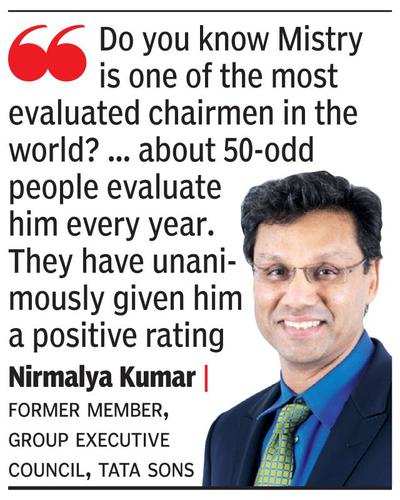- News
- Business News
- India Business News
- ‘Shared Tata strategy only with Trusts’
Trending
This story is from November 22, 2016
‘Shared Tata strategy only with Trusts’

Mumbai: Nirmalya Kumar, who was sacked by Tata Sons soon after his boss Cyrus Mistry was removed on October 24, plans to leave the country this month-end, and the one thought that continues to linger in his mind is the criticism that long-term strategy was missing at Tata Sons during his tenure.
That’s because Kumar, who was a professor at London Business School, was hired by Mistry for this precise reason.His job, the first such recruitment at Tata Sons, involved coming up with a blueprint for the group’s growth across sectors.
In his first interview since he was removed, Kumar told TOI that — as “a thought partner to the chairman” — he had helped Mistry put together plans detailing a vision “which includes growing existing businesses and developing new businesses”.
Known as the 2025 strategy document, he said it was presented by Mistry to the board of Tata Sons on three occasions: June 2015, December 2015 and June 2016. “After every presentation, Mistry would come back and ask me to incorporate changes suggested by the board,” said Kumar. He said Mistry had shared the strategy plan only with Tata Sons’ major shareholders, Tata Trusts, and not the other shareholders.
Kumar had rejected the Tata Sons offer initially. He said a global headhunter had approached him and he decided to accept the job only after an interaction with Mistry. He had told the former Tata Sons chairman that he would take up the assignment for a year and see how it worked. Kumar’s first year was spent in understanding the vast scale on which the conglomerate operated; the strategy began to take shape in the second year.
Kumar said he had met Ratan Tata twice, once for 10 minutes along with Mistry and another time during an hour-long meeting with several Tata executives. During his three and a half years at Bombay House, the group’s headquarters, Kumar said he did not have any inkling about the turmoil brewing at the top level.
“Do you know Mistry is one of the most evaluated chairmen in the world? Considering the number of boards he is on and his position, about 50-odd people evaluate him every year. They have unanimously given him a positive rating,” said Kumar, while questioning Tata Sons board’s decision to sack him “without even asking the independent directors/boards of other group companies”.
Kumar, who has three top universities offering him jobs and who threw a “thank-you” party at his apartment last week, said he will “take his time” to decide on his next move.
That’s because Kumar, who was a professor at London Business School, was hired by Mistry for this precise reason.His job, the first such recruitment at Tata Sons, involved coming up with a blueprint for the group’s growth across sectors.
In his first interview since he was removed, Kumar told TOI that — as “a thought partner to the chairman” — he had helped Mistry put together plans detailing a vision “which includes growing existing businesses and developing new businesses”.
Known as the 2025 strategy document, he said it was presented by Mistry to the board of Tata Sons on three occasions: June 2015, December 2015 and June 2016. “After every presentation, Mistry would come back and ask me to incorporate changes suggested by the board,” said Kumar. He said Mistry had shared the strategy plan only with Tata Sons’ major shareholders, Tata Trusts, and not the other shareholders.
Seeking to refute the charge that he didn’t fit into the Tata scheme of things, Kumar said he was anyway not hired for execution or to manage people but to develop strategy. Agreeing that he had never before worked in a corporate environment, the 56-year-old argued his case saying he’s been a consultant to Fortune 100 companies across the world, and that he came in with global experience. Before joining Tata Sons, he had served on the boards of ACC and Zensar Technologies, among others.
Kumar had rejected the Tata Sons offer initially. He said a global headhunter had approached him and he decided to accept the job only after an interaction with Mistry. He had told the former Tata Sons chairman that he would take up the assignment for a year and see how it worked. Kumar’s first year was spent in understanding the vast scale on which the conglomerate operated; the strategy began to take shape in the second year.
Kumar said he had met Ratan Tata twice, once for 10 minutes along with Mistry and another time during an hour-long meeting with several Tata executives. During his three and a half years at Bombay House, the group’s headquarters, Kumar said he did not have any inkling about the turmoil brewing at the top level.
“Do you know Mistry is one of the most evaluated chairmen in the world? Considering the number of boards he is on and his position, about 50-odd people evaluate him every year. They have unanimously given him a positive rating,” said Kumar, while questioning Tata Sons board’s decision to sack him “without even asking the independent directors/boards of other group companies”.
Kumar, who has three top universities offering him jobs and who threw a “thank-you” party at his apartment last week, said he will “take his time” to decide on his next move.
End of Article
FOLLOW US ON SOCIAL MEDIA
















